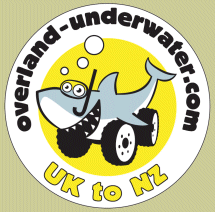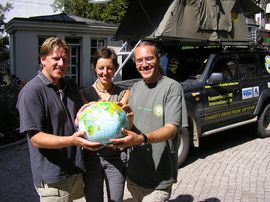| Final Statistics: Alex & Maz | Total distance: 93,550km |
| Furthest Point: Rotorua, NZ | Now settled in Sydney, Australia |
| Final Statistics: Martin | Total distance: 79,698km |
| Furthest Point: Hobart, Australia | Now settled in Bristol, UK |
More Pakistani stamps at the border
Pakistan and India, Countries 14 and 15, Diary entry 18th-24th Dec 2005, Total distance in Pakistan: 4867km, in India: 6813km
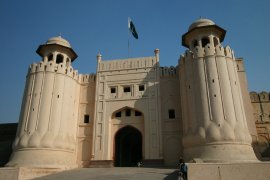 The drive to Lahore was a luxurious cruise along the superhighway we'd found on our way towards Islamabad, though I discovered that I had developed a nasty vibration when cruising at exactly 100km/h, our preferred cruising speed! So cruising just below the resonant point I made it to Lahore doing about 90km/h but this was still bliss compared to the narrow winding roads we'd been driving along further north.
The drive to Lahore was a luxurious cruise along the superhighway we'd found on our way towards Islamabad, though I discovered that I had developed a nasty vibration when cruising at exactly 100km/h, our preferred cruising speed! So cruising just below the resonant point I made it to Lahore doing about 90km/h but this was still bliss compared to the narrow winding roads we'd been driving along further north.
On our arrival at Lahore a reception had been set up for us courtesy of Aamir and Kabir from the Offroadpakistan trip at Hamid's mother's house (Hamid also of the Offroadpakistan trip who has the synthetic fibre factory in Karachi) - a lovely place in one of the nice districts of Lahore and perfectly safe and spacious for us and for our cars. The reception was a carton or two of "special orange juice" and after polishing that off in no time flat, we had dinner in the house. Once again the Pakistanis do themselves proud in the culinary stakes by giving us excellent traditional dishes, but I have to admit that my taste buds had been a little impaired by the special orange juice! Following the meal we were talking about our experiences along the Karakoram Highway and with Amjad in Islamabad, and Aamir had the excellent idea of going out for an ice cream. We jumped in the car and drove downtown and he treated us. It was a little bizarre to be standing on the street, being the centre of attention again (especially as the Pakistan-England test cricket series was in full flow at this time!) and eating a tutti-frutti ice cream! But those that were worried about my ice cream intake suffering the long stretch away from home need worry no longer; I still get the occasional one from time to time to keep me ticking over.
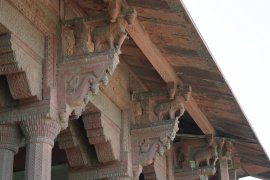 For our first day sightseeing in Lahore both Aamir and Kabir were busy but rather than let us fend for ourselves they lent us a car and driver and arranged a guide for us to show us around the main sights of the city! First stop Lahore Fort where we met our guide Sami.
For our first day sightseeing in Lahore both Aamir and Kabir were busy but rather than let us fend for ourselves they lent us a car and driver and arranged a guide for us to show us around the main sights of the city! First stop Lahore Fort where we met our guide Sami.
The fort itself has an impressive front gate and entrance way designed large enough and with shallow steps to allow members of the royal family to enter without dismounting from their elephants. Much of the interior is made of smaller palaces or rooms with not much between, but it gives a good insight into the styles of the individual Mughal emperors who made their mark on the fort as time passed. The fort had existed in various forms for some time but it was Emperor Akbar who in 1566 gave it its current form, Jehangir's sleeping quarters can be viewed, but it was the Shah Jahan who was responsible for the real gems in the fort including the Hall of Public Audience and the most ornate Shish Mahal, or Palace of Mirrors. The story goes that his favourite wife Mumtaz wanted the stars, so he gave her this marble palace completely encrusted in tiny mirrors, which when lit up at night looks like the constellations. Incurable romantic that the Shah Jahan was, when Mumtaz died he built his most famous creation in her memory: the Taj Mahal.
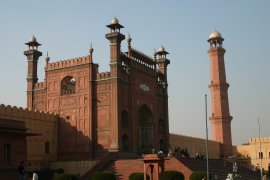 Directly opposite the main entrance to Lahore Fort is the main entrance to the Badshahi Mosque, created by Aurangzeb in 1674 and one of the Mughal emperors' final architectural works. With a courtyard capable of holding 100,000 people it is one of the world's largest mosques, and has a towering red sandstone minaret at each corner of the complex and three vast marble domes making up the business end of the mosque. From inside the courtyard it is a truly amazing sight (even for people who had already seen quite a few mosques!) and after a good look around we climbed up to the roof terrace of a nearby restaurant for a view from a different angle and better photo opportunity.
Directly opposite the main entrance to Lahore Fort is the main entrance to the Badshahi Mosque, created by Aurangzeb in 1674 and one of the Mughal emperors' final architectural works. With a courtyard capable of holding 100,000 people it is one of the world's largest mosques, and has a towering red sandstone minaret at each corner of the complex and three vast marble domes making up the business end of the mosque. From inside the courtyard it is a truly amazing sight (even for people who had already seen quite a few mosques!) and after a good look around we climbed up to the roof terrace of a nearby restaurant for a view from a different angle and better photo opportunity.
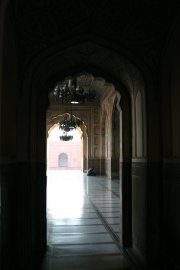 From there we walked into the Old City and around the bazaar, which was organised like most of the other bazaars we'd been to: all the fabric shops together, all the shoe shops together etc. Great for comparison shopping but not ideal for browsing because after 20 shoe shops they start to get less interesting. In the middle of the Old City was our last sight of the day - the Mosque of Wazir Khan, who was governor of Punjab in the time of Shah Jahan. This mosque was very small and nestled in amongst the shops and alleyways, and despite the fact that it's starting to fall apart it was very pretty. The sheer number of pigeons resident in and around the courtyard coupled with the requirement to remove one's shoes made it quite a challenge to move around the mosque but it was very pretty. We chatted to a couple of westerners there (we hadn't seen any others for a long time!) who turned out to be New Zealanders on their way home from spending time in Europe. This was the same story we told everyone in Iran but I think these people were telling the truth!
From there we walked into the Old City and around the bazaar, which was organised like most of the other bazaars we'd been to: all the fabric shops together, all the shoe shops together etc. Great for comparison shopping but not ideal for browsing because after 20 shoe shops they start to get less interesting. In the middle of the Old City was our last sight of the day - the Mosque of Wazir Khan, who was governor of Punjab in the time of Shah Jahan. This mosque was very small and nestled in amongst the shops and alleyways, and despite the fact that it's starting to fall apart it was very pretty. The sheer number of pigeons resident in and around the courtyard coupled with the requirement to remove one's shoes made it quite a challenge to move around the mosque but it was very pretty. We chatted to a couple of westerners there (we hadn't seen any others for a long time!) who turned out to be New Zealanders on their way home from spending time in Europe. This was the same story we told everyone in Iran but I think these people were telling the truth!
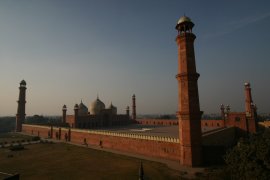 With our feeble legs totally knackered (how are we ever going to survive Nepal?) we all piled into a rickshaw for a ride back to car which was a very exciting experience, the three of us were facing backwards so we could get a good view of how close exactly everyone gets to each other in the Lahore traffic, and finally arriving back at the fort as the sun was starting to set, so we had to get another bunch of photos of the fort and the mosque, then we said goodbye to Sami and went back to the car.
With our feeble legs totally knackered (how are we ever going to survive Nepal?) we all piled into a rickshaw for a ride back to car which was a very exciting experience, the three of us were facing backwards so we could get a good view of how close exactly everyone gets to each other in the Lahore traffic, and finally arriving back at the fort as the sun was starting to set, so we had to get another bunch of photos of the fort and the mosque, then we said goodbye to Sami and went back to the car.
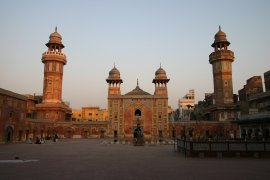 The driver took us to Aamir's office where he and Kabir had organised another reception for us. Aamir's office was the first time we'd seen internet for a couple of days so Alex disappeared first leaving Maz and myself to hold the fort with our hosts, then we swapped shifts and I took the computer, then it ended up Alex and I were both working on something that probably seemed important at the time leaving poor Maz on her own with Aamir and Kabir and the orange juice. We went out to Food Street, which is as the name suggests a street that does nothing but food. I particularly liked the concept and was even more taken by the no-nonsense name, so we had to go. The street is pedestrian-only at night and the restaurants set up tables outside, and you can sit at any restaurant and order whatever you like. If that restaurant doesn't do what you asked for they will send out a runner to go to another restaurant that does! We left ourselves in the charge of our hosts once more, and ended up with a very nice chicken handi (we like that one) and barbecue chicken which was also good. There was a strange puree dish that we couldn't work out though - the puree is the bread, which is like a small flat bread that puffs up into a ball when deep-fried. They were served with a hole knocked into one side and a few chick peas inserted so they rattle around inside. This comes with a thin soup-like liquid and the idea is to dip the puree into the liquid so the liquid goes inside, then get it into your mouth quickly before the puree disintegrates! I think the concept is that there is an explosion of flavours in the mouth but it might have helped if we had been expecting the liquid to be cold. As it was, it was quite an unpleasant surprise.
The driver took us to Aamir's office where he and Kabir had organised another reception for us. Aamir's office was the first time we'd seen internet for a couple of days so Alex disappeared first leaving Maz and myself to hold the fort with our hosts, then we swapped shifts and I took the computer, then it ended up Alex and I were both working on something that probably seemed important at the time leaving poor Maz on her own with Aamir and Kabir and the orange juice. We went out to Food Street, which is as the name suggests a street that does nothing but food. I particularly liked the concept and was even more taken by the no-nonsense name, so we had to go. The street is pedestrian-only at night and the restaurants set up tables outside, and you can sit at any restaurant and order whatever you like. If that restaurant doesn't do what you asked for they will send out a runner to go to another restaurant that does! We left ourselves in the charge of our hosts once more, and ended up with a very nice chicken handi (we like that one) and barbecue chicken which was also good. There was a strange puree dish that we couldn't work out though - the puree is the bread, which is like a small flat bread that puffs up into a ball when deep-fried. They were served with a hole knocked into one side and a few chick peas inserted so they rattle around inside. This comes with a thin soup-like liquid and the idea is to dip the puree into the liquid so the liquid goes inside, then get it into your mouth quickly before the puree disintegrates! I think the concept is that there is an explosion of flavours in the mouth but it might have helped if we had been expecting the liquid to be cold. As it was, it was quite an unpleasant surprise.
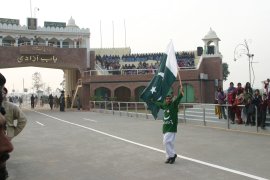 The next day was a bit of a mad panic where I spent the morning at Toyota trying to fix the stuff they couldn't do in Islamabad - basically moving the auxiliary fuel pump somewhere that it wouldn't get hit by the suspension, and bending the load sensor back into shape again. To fix the vibration they also balanced the wheels which were well out, despite some magic powder having been put inside the tyres in the UK that was supposed to do that automatically. Nothing major, but it was very slow going and as usual I had to keep an eye on what they were doing (lucky I did because they were about to do some really nasty bodge work on the load sensor!). Aamir was on the phone on regular occasions trying to find out what was going on because we had a booking at that evening's border closing ceremony at Wagah and we had to be setting off from Lahore at around 2pm at the latest (the border is about 30km away). We were a little late leaving Toyota but we arrived at the border just in time.
The next day was a bit of a mad panic where I spent the morning at Toyota trying to fix the stuff they couldn't do in Islamabad - basically moving the auxiliary fuel pump somewhere that it wouldn't get hit by the suspension, and bending the load sensor back into shape again. To fix the vibration they also balanced the wheels which were well out, despite some magic powder having been put inside the tyres in the UK that was supposed to do that automatically. Nothing major, but it was very slow going and as usual I had to keep an eye on what they were doing (lucky I did because they were about to do some really nasty bodge work on the load sensor!). Aamir was on the phone on regular occasions trying to find out what was going on because we had a booking at that evening's border closing ceremony at Wagah and we had to be setting off from Lahore at around 2pm at the latest (the border is about 30km away). We were a little late leaving Toyota but we arrived at the border just in time.
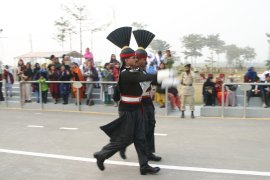 The border closing ceremony is the most remarkable sight. The basic idea is that the soldiers on each side of the border march around stamping their feet as hard as possible and bellowing at each other in an attempt to outdo the troops on the other side, while others whip the crowds up into a frenzy of screaming and shouting in support of their own troops. The ceremony has become so popular that grandstands have been constructed to accommodate all the supporters from each country along with a handful of western tourists who turn up every day.
The border closing ceremony is the most remarkable sight. The basic idea is that the soldiers on each side of the border march around stamping their feet as hard as possible and bellowing at each other in an attempt to outdo the troops on the other side, while others whip the crowds up into a frenzy of screaming and shouting in support of their own troops. The ceremony has become so popular that grandstands have been constructed to accommodate all the supporters from each country along with a handful of western tourists who turn up every day.
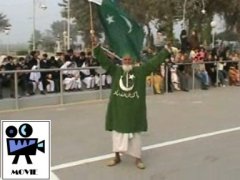 It starts with the commanding officers of each side marching up to the border and exchanging the briefest of handshakes with each other before turning round and marching away, then the soldiers goose step around a bit more, stamping so hard it involves lifting the foot level with one's head before stamping down, which gives the ceremony a comical Pythonesque silly walks air, and shout a bit more, blow bugles etc. until the flag lowering part of the ceremony. The flags for each side are right on the border and they are lowered in synch with each other, at an absolute snail's pace - each side tries to be slower than the other for if one were faster, their flag would be lower than the other signifying inferiority. So it was like watching a slow race until the flags were finally down, then packed away, gates slammed shut and the ceremony was over.
It starts with the commanding officers of each side marching up to the border and exchanging the briefest of handshakes with each other before turning round and marching away, then the soldiers goose step around a bit more, stamping so hard it involves lifting the foot level with one's head before stamping down, which gives the ceremony a comical Pythonesque silly walks air, and shout a bit more, blow bugles etc. until the flag lowering part of the ceremony. The flags for each side are right on the border and they are lowered in synch with each other, at an absolute snail's pace - each side tries to be slower than the other for if one were faster, their flag would be lower than the other signifying inferiority. So it was like watching a slow race until the flags were finally down, then packed away, gates slammed shut and the ceremony was over.
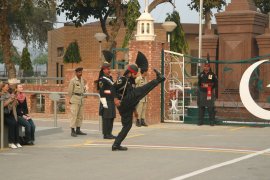 Never one to miss an opportunity Aamir approached the commanding officer at the end of the ceremony and told him that his flag rope was not white enough and they should make sure their rope was whiter and shinier than the Indians', and he might be able to give them a free roll of whiter than white rope with sparkly bits. The commanding officer asked what other business apart from rope... and so started a business meeting. Smooth move Aamir! We also got a photo opportunity with the soldiers, and we were proud that we made the most serious one of them, one who looked like Bluto out of Popeye, with the highest of high-kicks, break his stony face and show a glimmer of a smile in the corner of his mouth as we goaded him. Our respect for authority continues :)
Never one to miss an opportunity Aamir approached the commanding officer at the end of the ceremony and told him that his flag rope was not white enough and they should make sure their rope was whiter and shinier than the Indians', and he might be able to give them a free roll of whiter than white rope with sparkly bits. The commanding officer asked what other business apart from rope... and so started a business meeting. Smooth move Aamir! We also got a photo opportunity with the soldiers, and we were proud that we made the most serious one of them, one who looked like Bluto out of Popeye, with the highest of high-kicks, break his stony face and show a glimmer of a smile in the corner of his mouth as we goaded him. Our respect for authority continues :)
 After the ceremony we returned to Lahore for our evening's dinner date - a meal at the Gymkhana Club, courtesy of Hanif Choudhry, the third of the Lahore guys who'd been on our trip through the desert. We were very concerned that we didn't have suitable dress for such a grand venue but we were told we'd be OK - when we got there we found that we were indeed a little underdressed compared to the other diners but the venue itself was one of perhaps a little faded glory. It was obviously very grand in its day but like many things in Pakistan, just a little unkempt and in need of a lick of paint. With its sporting trophies and honours boards it reminded me very much of my old school.
After the ceremony we returned to Lahore for our evening's dinner date - a meal at the Gymkhana Club, courtesy of Hanif Choudhry, the third of the Lahore guys who'd been on our trip through the desert. We were very concerned that we didn't have suitable dress for such a grand venue but we were told we'd be OK - when we got there we found that we were indeed a little underdressed compared to the other diners but the venue itself was one of perhaps a little faded glory. It was obviously very grand in its day but like many things in Pakistan, just a little unkempt and in need of a lick of paint. With its sporting trophies and honours boards it reminded me very much of my old school.
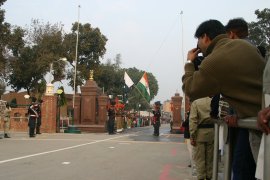 Knowing we'd be entering India the next day we took our last opportunity to eat some beef and each had a lovely steak, and after a few busy days we were all tired so we declined the offer for a game of snooker (they gave us some quizzical looks when we entered the snooker room with ladies anyway!) and returned home for sleep.
Knowing we'd be entering India the next day we took our last opportunity to eat some beef and each had a lovely steak, and after a few busy days we were all tired so we declined the offer for a game of snooker (they gave us some quizzical looks when we entered the snooker room with ladies anyway!) and returned home for sleep.
 The next morning we managed to squeeze in a quick visit to the Fatimid Association which is where Saba Choudhry, Hanif's wife, works. We were greeted with cups of tea all round then we were shown round the facility. Basically the centre is for underprivileged children with blood disorders. Many children are not admitted into the Pakistani health system for treatment and without organisations such as the Fatimid Association they simply would not have any treatment at all. We were shown around the labs as well where there is a bare minimum of expensive-looking equipment, and we found that all of it was donated to the organisers by private benefactors. One of the biggest problems they face is not the sourcing of blood in the first place, though that is a problem, but screening it. Of course it must be screened for various diseases before it can be used, and with their limited resources they face a constricting limit to the amount of treatment they can provide the children with.
The next morning we managed to squeeze in a quick visit to the Fatimid Association which is where Saba Choudhry, Hanif's wife, works. We were greeted with cups of tea all round then we were shown round the facility. Basically the centre is for underprivileged children with blood disorders. Many children are not admitted into the Pakistani health system for treatment and without organisations such as the Fatimid Association they simply would not have any treatment at all. We were shown around the labs as well where there is a bare minimum of expensive-looking equipment, and we found that all of it was donated to the organisers by private benefactors. One of the biggest problems they face is not the sourcing of blood in the first place, though that is a problem, but screening it. Of course it must be screened for various diseases before it can be used, and with their limited resources they face a constricting limit to the amount of treatment they can provide the children with.
After being loaded up with bumf, and a quick fuel stop, we were escorted to the border by the guys (I think they were checking we were really leaving!) and after the inevitable paperwork to get the cars out of Pakistan, we made our way to the same frontier gates they had slammed so hard the previous evening and then had to wait ten minutes for a little traffic jam to dissipate because none of the lorries were actually crossing the border, they had a Pakistani one on one side and an Indian one on the other and they were transferring the load from one to the other by hand! Eventually they finished and cleared the way; we passed through the gates and into India, country number 15 of the trip!
It's only another 30km from the border to Amritsar where we had another contact briefed and ready for our call, this time a chap named Arun Varma, who was at school with Aamir (along with most of the important people in Punjab it seems!). We called him on our arrival and he took us to a very nice 4* hotel in the town. Unfortunately Mr. Varma's English was not really forthcoming (we got the impression he could speak quite well but chose not to) so we weren't really sure what was going on and we had to sheepishly ask the receptionist who was paying, they said they thought it would probably be Mr. Varma. He disappeared for a while leaving us to have our first beer that we could purchase and drink openly in the hotel bar. Then he returned and took us to the Tourist Guest House where we were left again while we ate (very good food!) and we used the internet, and then he finally returned at about 11pm, about 2 hours later than planned and well after we were ready to go home to bed. We had a quick dessert stop on the way home where we sampled a dish called gulab jamun, which is like a dumpling of reduced milk dough deep fried and served in syrup - really nice, but our decision to have seconds was perhaps a little unnecessary!
The next day we got up and checked out of the hotel (we still weren't sure what the deal was with the hotel) and went to the main sight of Amritsar - the Golden Temple. This is the holiest shrine of the Sikh religion and consists of a large open square with a marble walkway surrounding the sacred pool, in the centre of which is the golden temple itself. Leaving our shoes outside and covering our heads in most fetching orange headscarves we picked up from a vendor outside we entered the square and there was the temple - a most impressive building somehow managing to glitter even though there was a thick mist hovering over the sacred pool. Cutting through the mist was the sound of priests keeping up a continuous chant from the Sikh holy book, the Guru Granth Sahib, broadcast around the square by loudspeaker, and around the perimeter of the pool the faithful were stripping off for a ritual bathing in the water. Didn't look too inviting to me (and it was quite cold too) but there were plenty of koi carp living in there so I guess it must have been clean enough.
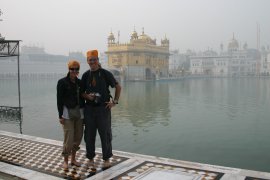 We walked right round the perimeter of the pool to the Akal Takhat building which is where the Sikh parliament meet, and so was the target of military action during the unrest in the early 1980s. A number of extremists intent on a Sikh homeland, by violence if necessary, occupied this building and following a lengthy siege the deadlock was finally broken by then Prime Minister Indira Gandhi sending in the army to evict them, resulting in hundreds of Sikh deaths and immense damage to the temple. Indira Gandhi was subsequently assassinated by her Sikh bodyguards, which strikes me as a little short-sighted of her. About two weeks after our visit to the temple some workmen discovered a bag of hand grenades from this era which had been hidden under the main marble walkway, but apparently there was nothing to worry about according to the report, they weren't dangerous hand grenades!!
We walked right round the perimeter of the pool to the Akal Takhat building which is where the Sikh parliament meet, and so was the target of military action during the unrest in the early 1980s. A number of extremists intent on a Sikh homeland, by violence if necessary, occupied this building and following a lengthy siege the deadlock was finally broken by then Prime Minister Indira Gandhi sending in the army to evict them, resulting in hundreds of Sikh deaths and immense damage to the temple. Indira Gandhi was subsequently assassinated by her Sikh bodyguards, which strikes me as a little short-sighted of her. About two weeks after our visit to the temple some workmen discovered a bag of hand grenades from this era which had been hidden under the main marble walkway, but apparently there was nothing to worry about according to the report, they weren't dangerous hand grenades!!
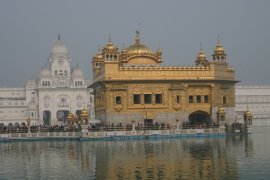 We walked across the causeway to the golden temple itself and saw the priests chanting from the holy book and admired the temple from close up (resisting the temptation to try to pull off some of the gold - the temple is gilded with 750kg of pure gold, I'm sure they wouldn't miss a few ounces!!). There were many pilgrims crowding in to see the priests and to pray, some even joining in with the chanting, and it was a wonder that so many bushy beards could fit into one small room.
We walked across the causeway to the golden temple itself and saw the priests chanting from the holy book and admired the temple from close up (resisting the temptation to try to pull off some of the gold - the temple is gilded with 750kg of pure gold, I'm sure they wouldn't miss a few ounces!!). There were many pilgrims crowding in to see the priests and to pray, some even joining in with the chanting, and it was a wonder that so many bushy beards could fit into one small room.
Finally leaving the temple, after posing for photos for many groups of Indian tourists, we proceeded to the gardens next door - the Jallianwala Bagh. These gardens are infamous as the site of an appalling massacre. During a demonstration by 20,000 Indians against British rule in 1919 the crowds were ordered to disperse and when they didn't (because of the high walls surrounding the gardens and British troops blocking the only exit) the troops were ordered by General Dyer to open fire on the crowd, resulting in 379 Indian deaths and around 1500 wounded. It was this event that prompted Gandhi to instigate his famous program of civil disobedience. We'd already heard this story as it was General Dyer's fort we'd visited in Saindak on our first day in Pakistan. Today the gardens are a peaceful place with a monument in the centre as a memorial to the dead, and an eternal flame to one side, proudly sponsored (so the overly large sign told us) by Indian Oil.
Unfortunately apart from those two sights, the rest of Amritsar is a big dump so we headed off to our night's accommodation. We decided to spend the night at the Tourist Guest House because the food had been good the night before and there was a big enough forecourt for us to park our Land Cruisers. We phoned Mr. Varma to say thanks for his hospitality the night before and when he found we were at the Tourist Guest House he came along to say hello and join us for a beer. He introduced us to the owner of the TGH, a chap with the great name of Bubbles Goolry, and it turned out that they were both most amused that we'd chosen this place over Mr. Varma's 4* hotel - that's right, his hotel! Oh well, we were established in the new place by then and we had a pleasant evening talking to Bubbles and his friend Captain Kanwaljit, a recently-retired merchant navy captain - as you can imagine very well travelled and absolutely full of stories. One beer turned into two turned into three etc. and we went to bed rather late, with the promise of a visit to their farm the next evening and a barbecue. We hadn't planned anything for the next few days, our first commitment being to meet my and Maz's brothers on their arrival in Delhi a few days later, so we decided to hang around.
Maz and I paid a brief visit into the market area of town to try to find a decent map of India, and then before we knew it, it was time for the barbecue. We were taken out of town by their driver to their little farmhouse. It was a beautiful setting amongst the fields, with only a little land for a few vegetables, but a very welcome break from the noise of the city. We had a beer and sat chatting around a camp fire for a couple of hours before heading back to the guest house for the barbecue... another couple of drinks and we met Mrs. Bubbles (we have no idea if she has a real name!)... no barbecue... we were just about to give up when finally the food arrived at about 11pm! We stuffed down some chicken with lemon coating, and sweet potatoes cooked in foil in the embers (which were lovely) and pretty much straight afterwards we went to bed.
The next day was Christmas Eve and we set off on our meandering route towards Delhi, but en route our aim was the Corbett Tiger Park to spend Christmas Day looking for tigers! The road was AWFUL! Although it was a dual-carriageway, only one lane was useable for 4 wheel motor vehicles because the slow lane was full of everything you could imagine: bicycles, scooters, rickshaws, camels, bullock carts, and we even saw an elephant being driven along the road. Add this to the number of buses and lorries, and it made for pretty slow-going. It was clear we weren't going to get all the way to the park in one day, and as we took to the smaller roads to make our way to the park it started to get dark. Normally we have a rule about not driving after dark, but we seem to keep breaking it. Unfortunately I discovered the hard way why we made this rule as I came up upon a bullock cart carrying sugar cane which I didn't see until too late because of a truck coming the other way with its headlights on full beam. I managed to swerve but ended up carving a big gouge up the side of my Land Cruiser causing quite a lot of cosmetic damage to a number of panels and both doors. I think the guys on the cart were more surprised than anything but they probably lost a few sticks of sugar cane.
Despite wanting to stop for the night, there was really nowhere to camp as it's all farmland and there are people everywhere, so we had to make it to the next town where we found a reasonable hotel, had a reasonable meal and a couple of reasonable beers and went to bed early to await the arrival of Santa. Merry Christmas to all!
| All content copyright � overland-underwater.com - please do not use without permission. |
